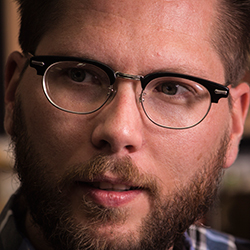Tattoo artist Tim Beck on traditionalism, craftsmanship and the mainstreaming of an outsider art form.
“This was my first one,”he explains, pointing to a simple, black laurel leaf on his right shoulder. A string of red-and-black stars trickles down his bicep, an array of iconic symbols decorating both arms. A vibrant red heart with a banner unfurls his daughter’s name; numerous eagles symbolize his patriotism; and a cross near his left hand proclaims his faith in Christ. For Tim Beck of Freedom Ink Tattoo Co., each line and shade is a permanent imprint of a moment shared, a memory never to be forgotten. “Any tattoo will always be yours and that artist’s,” he notes. “It’s going to be personal—and to a time.”
Ethics Instilled
A native of Creve Coeur, Tim Beck grew up the son of a Korean War veteran and dedicated Caterpillar worker, who instilled in him the value of hard work. “He never missed a single day,” Beck recalls. “Even if he was hurting, he still made it.” But a strong work ethic was not his dad’s only influence. His father’s two tattoos—one an anchor, the other an eagle—signified his days in the Navy and devotion to his country, but to his son, they held a mystical allure. “As a kid, those tattoos engrained what I thought a man should be,” he laughs.
Having picked up pencil and paper as a six-year-old, Beck’s creative gifts were evident from a very young age. “I remember drawing constantly,” he recalls, “and my brother had guitars that I would jangle around with.” He credits The Secret City Adventures, a PBS program that taught children how to draw, and its host, “Commander Mark,” with cultivating his talents as a youth. “I remember following along with a pencil. He was a phenomenal artist… He taught you like an adult, and I always liked that.”
During his high school years, Beck turned his attention to music, playing in a number of punk and ska bands, but despite some regional success, he knew he couldn’t make ends meet as a musician. Then, at age 17, he got his first tattoo. “I watched the guy do it, [and thought] man, I could do better than that… Which is wrong to be that prideful, but just watching him is what really got me into tattooing.” Tim Beck’s search for another creative outlet—and a lifelong profession—was over.
 On the Way Up
On the Way Up
“I bought a little tattoo kit and tried it on a few friends, which is the wrong way to learn,” he laughs. “But pretty early on, I figured that I needed to learn right.” He sought out tattoo artists in the area to help train him, but back then, there were few to be found. “[Tattooing] had a stigma attached to it—a biker mentality and a gang mentality. Prisoners had them. There were only a few shops in the area.”
Eventually, Pekin artist Nick McCarty of Nick’s Tattoos took him under his wing. “Nick was upgrading his shop to a new location and was looking for an apprentice, so it was perfect timing.” McCarty became his teacher and mentor, but Beck is quick to cite other local artists who also paved the way: Wanda Harper of I’m No Angel Productions, Tony Kelly of Hybrid Art Studios, Smitty of Smitty’s Tattoos, Dan Koch of The Ink Stop and Kay Davis of Dream Illustrations. “I always respected them because they were around before it was ‘cool.’ And I respect Wanda and Kay even more…”—it wasn’t easy being female in a male-dominated industry.
From there, Beck set out to master all the skills necessary to utilize the human body as a canvas. “You’re learning anatomy, the art and history of tattooing, and also how art works with the anatomy… like how does it stain the dermis, and how does it last?,” he explains. “You need to be taught that for years to really know it.”
His apprenticeship with McCarty lasted about five years, then Beck moved northward to the Chicago outlier of Elgin, where he worked for a time under an artist called Cleen Rock One. “I was one of those naïve people that thought you have to go to a big city,” he asserts. Returning to central Illinois in 2004, he worked briefly at Artkore Tattoo in Bloomington before founding his own shop, Freedom Ink, in 2006.
The Timeless Medium
Ascribing to a style known as traditionalism, Beck is committed to the old-school, classic look and method of application. “A lot of times, we try to change things that don’t need to be fixed,” he declares. “[Tattooing] has gone through its phases, but it seems like it always comes back to the traditional style.”
Having trained in the age of “new school”—a style distinguished by freestyling, bright colors, unique patterns and an almost-cartoonish look—his faith in traditionalism remains firm. “People were trying to take it in new directions, but they were also pushing boundaries a little too much,” Beck claims. “It brought in new things, but tattooing is what it is. It’s like an old oak cabinet: it looks good just how it is.”
Characterized by bold lines, heavy blacks and solid colors, tattoos in the traditionalist style are intended to be timeless. Religious and patriotic figures are common, along with other iconic imagery: daggers, anchors, hearts and roses—each holding a unique symbolism. “All that old stuff has some sort of meaning,” he explains. “A rose wasn’t tattooed for no reason. The point of a rose was the beauty and shortness of life—how it has thorns, and how it has hardships.”
In contrast, he expresses frustration with a number of contemporary trends, such as the overuse of text. “We’re doing big blocks of text, as much as several paragraphs,” he describes. “You could write out the entire Declaration of Independence—or you could just get an eagle, which means the same thing. That’s what these images are: they’re to sum up a block of text.”
 Much of Beck’s frustration amounts to his belief that many modern tattoos are simply not made to last. “Sometimes people are getting things that sound like good ideas but aren’t,” he explains. “That big block of text is going to be a blurred rectangle down the road. A lot of people don’t want to hear that—they want to get what they want.
Much of Beck’s frustration amounts to his belief that many modern tattoos are simply not made to last. “Sometimes people are getting things that sound like good ideas but aren’t,” he explains. “That big block of text is going to be a blurred rectangle down the road. A lot of people don’t want to hear that—they want to get what they want.
“There’s this new style they’re calling watercolor,” he continues. “They’re beautifully done—they look fantastic now. But they’re just fundamentally wrong. I don’t like artsy stuff too much, or pushing too many boundaries, because in the end, it’s skin, so you’re limited.
“You’ve got to know your medium, and sometimes people don’t know those boundaries. They want to do that oil painting with skin, and of course, it looks beautiful for the first four years. But I want them to last forever, like they’re supposed to.”
A Double-Edged Sword
In recent years, the Internet has helped boost the popularity of tattooing and driven all kinds of trends in his industry, but Beck sees it as a double-edged sword. “I love how much it’s clued people into what tattooing is and opened people’s eyes that it is a valid art form. But at the same time, it made it possibly too popular.
“We’re doing things on people who might not normally have gotten a tattoo,” he continues. “A lot of it seems very temporary—they look at it as an accessory to clothing, and they’ll remove it one day.” But for Beck, a tattoo is no transitory thing; it should be forever. “You shouldn’t ever think, ‘Well, if it doesn’t look good, I’ll remove it.’
“The sad thing is, the Internet has kind of hurt the sacredness of tattooing,” he adds. “What made tattooing an outsider art is almost gone.”
Despite strong opinions on his craft, Beck is warm and accommodating, and his talents are not limited by his preferences. “I think you should do whatever comes in the door,” he says. “I’m big on the traditional stuff, but… I’m a versatile guy. I don’t think you should pick and choose; you should do whatever that person wants, even if it may be against your better judgment. We are here to provide a service, so we will do the best we can, make the customer happy, and hopefully, make it a substantial tattoo that will last.”
The Objective Craftsman
“I almost don’t even view myself as an artist,” Beck laughs. “I realize what I do is art, but at the end of the day, I’m a craftsman. I’m trying to make this buzzing, vibrating machine make a beautiful picture on you. I’m like a dentist.
“These guys always laugh about it—that I’m always saying I’m not an artist… But I don’t really like that weird expressionist feeling of art… like where people say, ‘I get a feeling out of this’ or ‘I release something.’ I’m not doing it for that.”
For Beck, the appeal of his craft actually lies in its own limitations. “I appreciate the classic style, mainly because… there is generally a right and wrong, with little exception. So much art is subjective. The thing that’s beautiful about tattooing is that it’s not really subjective. It has to be something that is understood, it has to be iconic, and it has to be good. That’s why I like it: there’s no in-between.”
Heart in the Heartland
Highly regarded in his field, Beck has received a range of awards and national recognition. He’s tattooed at some of the world’s most notable conventions and is frequently featured in the world’s top tattoo magazines. His shop is currently situated in a strip mall on Farrelly Avenue, where he works with his partners, artists Zach Dole and Jeremy Armstrong. This fall, however, Freedom Ink is moving to Peoria’s Warehouse District, where Beck feels he can be on the frontlines of Peoria’s downtown revitalization.
“A lot of people move away with the mentality that there’s nothing cool here, but I’m the kind of guy that says I’ll make it cool here,” he declares. “That’s why I’m going to the riverfront: I want to be part of what makes Peoria vibrant again. I’ve made it to the point where I’m well-known and could make it anywhere, but Peoria’s the place I want to be.” a&s
To learn more about Tim Beck and Freedom Ink, visit freedominktattoos.com, find them on Facebook, or follow him on Instagram @timbecktattoos.


